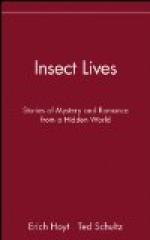Among those Diptera whose larva is the headless maggot a most remarkable arrangement for protecting the pupa is to be found. The last larval cuticle, instead of being as usual worked off and cast, after separation from the underlying structures, becomes hard and firm, forming a protective case (puparium) within which by the processes of histolysis and histogenesis already described the organs of the pupa and imago are built up. This puparium (fig. 22 d) is usually dark in colour, often brown and barrel-shaped, and a subcircular lid splits off from it at the head-end to allow the emergence of the fly[11]. While the maggot breathes by its tail-spiracles, the functional spiracles of the puparium (connected with the tracheal system of the enclosed pupa) are far forward, and these may be situated at the tips of long sometimes branching processes, which recall the thoracic gills of the aquatic pupae mentioned a few pages above. Adaptations, various and beautiful, to special modes of life, are thus seen to characterise pupae as well as larvae.
[11] The presence of this sub-circular lid characterises Brauer’s suborder Cyclorrhapha. Those Diptera in which the pupal cuticle splits in the normal, longitudinal manner are included in the Orthorrhapha (see p. 67).
CHAPTER VIII
THE LIFE-STORY AND THE SEASONS
A number of interesting questions are associated with the seasonal cycle of an insect’s life-history. In a previous chapter (IV. pp. 30, 34) reference has been made to the contrast between the long aquatic life of the larval dragon-fly or may-fly, extending over several years, and the short aerial existence of the winged adult restricted in the case of the may-flies to a few hours. Here we see that the feeding activities of the insect are carried on during the larval stage only; the may-fly in its winged condition takes no food, pairing and egg-laying form the whole of its appointed task. A similar though less extreme shortening of the imaginal life may be noticed in many endopterygote insects. For example, the bot- and warble-flies have the jaws so far reduced that they are unable to feed, and the parasitic life of the maggot (see p. 74) extending over eight or




